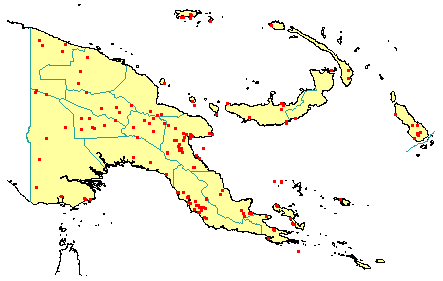
in PNGplants database
PNGTreesKey – Pipturus argenteus (G.Forster) Wedd. |
Barry Conn (NSW) & Kipiro Damas (LAE).
Guide to trees of Papua New Guinea
Copyright held by the authors, National Herbarium of New South Wales, and Papua New Guinea National Herbarium
Prodromus Systematis Naturalis Regni Vegetabilis, Sive Enumeratio Contracta Ordinum Generum Specierumque Plantarum Huc Usque Cognitarum, Juxta Methodi Naturalis Normas Digesta Vol. 16 Part 1: 235 (1869)
Family: Urticaceae
Dicotyledon
Timber Group: Non-timber species
Field Characters: Small sub-canopy tree (10-20 m high); Bole cylindrical (almost 10-18 cm diam.); crooked (trunk mostly branching from near base, hence bole usually very short); buttresses buttresses absent; spines spines absent; aerial roots aerial roots absent; stilt roots stilt roots absent; Bark green or brown (colours in stripes), slightly rough or smooth, pustular, lenticels elongated laterally; Subrhytidome (under-bark) green; less than 25 mm thick; bark blaze consisting of one layer; faintly to non-aromatic; outer blaze white or green, markings absent; inner blaze white or green, markings absent; bark exudate (sap) present, colourless, not readily flowing (spotty), colour not changing on exposure to air, not sticky; terminal buds not enclosed by leaves.
Indumentum: Complex hairs absent; stinging hairs absent; mature twig indumentum (hairs) present, hairs dense.
Leaves: Leaves spaced along branches, spiral (leaves occurring singly at a node and arranged spirally up the branchlet), simple (a leaf composed of a single blade); petiole present, not winged, attached to base of leaf blade, not swollen; leaves sometimes broadest at or near middle or broadest below middle, (11.0-) 13.0-18.0 cm, (3.5-) 6.0-12.0 cm; symmetric, serrate to dentate (toothed), not dissected or lobed, acuminate or slightly long-tapering, venation pinnate or at base trinerved, secondary veins open, prominent, intramarginal veins absent; leaves lower surface blue-green or slightly pale green, upper surface dull green, indumentum (hairs) present, indumentum (hairs) dense (coarsely hairy); absent; domatia absent; stipules present, joined, joined across twigs, not encircling the twig, leafy, not fringed, large (5-6 mm long), not persistent.
Flowers: Inflorescence axillary, flowers on an unbranched axis, cones absent; flowers unisexual, unisexual with male and female flowers on different plants, not stalked (female flowers), flowers with many planes of symmetry or slightly asymmetric, 1.0-(c. female flowers; male flowers)-1.3 mm long, diameter small (up to10 mm diam.) (up to c. 1 mm diam.); perianth present, petals absent, inner perianth white or green (sepals); 4, some or partly joined (male flowers) or all joined (female flowers); stamens 4 (male flowers), present, free of each other, free of the perianth; ovary superior (female flowers), carpels joined (when more than one), locules 1; styles solitary, 1.
Fruits: Infrutescence arranged on unbranched axis, fruit 0.7-1.0 mm long, white, cream-coloured, or pale brown, not spiny, non-fleshy, simple, indehiscent, nut; seeds 1, barely visible (to 1 mm long) (up to c. 1 mm long), not winged, broad (as wide as long), seed less than 1 mm diam.
Distribution: West Sepik, East Sepik, Madang, Morobe, Western Highlands, Eastern Highlands, Southern Highlands, Western, Gulf, Central, Northern, Milne Bay, Papuan Islands, New Britain, New Ireland, Manus & Bougainville.
 | Botanical records in PNGplants database |